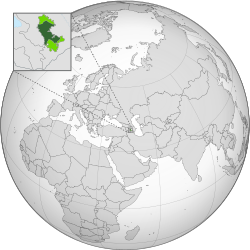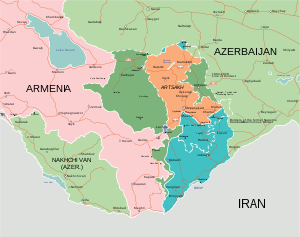Republic Of Artsakh: De-facto state in South Caucasus (1992–2024)
Artsakh (officially the Republic of Artsakh; /ˈɑːrtsæx/; Armenian: Արցախի Հանրապետություն, Artsakhi Hanrapetutyun), or the Nagorno-Karabakh Republic (/nəˌɡɔːrnoʊ kærəˈbæk/), was a separatist state in the Nagorno-Karabakh region of the South Caucasus.
It controlled its own land but is legally part of Azerbaijan.
Republic of Artsakh Արցախի Հանրապետություն Artsakhi Hanrapetutyun Нагорно-Карабахская Республика Nagorno-Karabakhskaya Respublika | |
|---|---|
| Anthem: Ազատ ու Անկախ Արցախ (Armenian) Azat u Ankakh Artsakh (transliteration) "Free and Independent Artsakh" | |
 Territory controlled by Artsakh in dark green, claimed territory in light green. | |
| Status | Unrecognised state Recognised by 3 non-UN members |
| Capital and largest city | Stepanakert 39°52′N 46°43′E / 39.867°N 46.717°E |
| Official languages | Armenian and Russian |
| Demonym(s) | Artsakhi |
| Government | Unitary presidential republic |
• President | Samvel Shahramanyan |
• President of the National Assembly | Arthur Tovmasyan |
| Legislature | National Assembly |
| Independence from the Soviet Union | |
• Autonomy | 2 September 1991 |
• Declared | 10 December 1991 |
| Area | |
• Total | 3,170 km2 (1,220 sq mi)[source?] |
| Population | |
• 2015 census | 150,932 (191st) |
| GDP (PPP) | 2019 estimate |
• Total | $713 million (n/a) |
• Per capita | $4,803 (n/a) |
| Currency | (AMD) |
| Time zone | UTC+4 (AMT) |
| Driving side | right |
| Calling code | +374 47c |
| ISO 3166 code | AM |
| Internet TLD | .am, .հայ |
| |
History
Armenian people have lived there since classical antiquity. In the 11th century the Seljuk invasion swept over the Middle East, including the South Caucasus. Nomadic Turkic Oghuz Seljuk tribes, which also include the Azerbaijanis, came during this invasion. They became dominant in Nagorno-Karabakh. From this time, until the beginning of the 20th century, these tribes used Mountainous Karabakh as their summer pastures. They stayed there for about four to five months per year, and in fact, they owned the region.
Armenia and Azerbaijan have disputed the area since 1918. After the Soviet Union established control over the area, in 1923 it formed the Nagorno-Karabakh Autonomous Oblast (NKAO) within the Azerbaijan SSR. In the final years of the Soviet Union, Armenia and Azerbaijan started to dispute the region again. This dispute caused the Nagorno-Karabakh War from 1993 to 1994.
On 10 December 1991, a referendum (vote) was held in the NKAO and the neighbouring Shahumian region. The referendum asked voters the question: "Should this area be independent from Azerbaijan?" The Azerbaijani people boycotted the referendum: they protested by choosing not to vote. This resulted in a declaration of independence from Azerbaijan as the Nagorno-Karabakh Republic. The country was not recognized by any UN member state, including Armenia.
There was dispute over the country's status ever since it was created. Azerbaijan claimed that they had the right to control Artsakh. Armenia supported Artsakh. From 2020 to 2023, there were multiple fights between Artsakh and Azerbaijan. On 28 September 2023, President Samvel Shahramanyan signed a deal with Azerbaijan's government to close down Artsakh's government by 1 January 2024, bringing an end to Artsakh. By October, almost all of the population had fled to Armenia.


Geography
The Artsakh Republic has a lot of mountains. It is 11,500 km2 (4,440 sq mi) in area, and borders Armenia, Azerbaijan, and Iran. The highest peaks in the country are Mount Mrav, 3,340 metres (10,958 ft), and Mount Kirs 2,725 metres (8,940 ft). The major rivers are the Terter and Khachen rivers. Most rivers in the country flow towards the Artsakh valley.
The climate in the Artsakh Republic is mild. It is foggy for over 100 days a year. More than 36% of the country is forested.
Demographics
In 2005, the country's population was 137,737. The ethnic composition was 137,380 (99.74%) Armenians, 171 (0.12%) Russians, 21 (0.02%) Ukrainians, 6 (0.00%) Azerbaijanis and 159 (0.12%) others.
The first demographic census in the Artsakh Republic took place in 1769. It was a letter from Heraclius II of Georgia to Russia's Petr Ivanovich Panin, and said, "Seven families rule the region of Khamse. Its population is totally Armenian."
In 2014, the life expectancy for males was 71.6 years, and females 76.8 years.
References
Other websites
- Official websites
- Ministry of Foreign Affairs of the Nagorno-Karabakh Republic Archived 2017-09-17 at the Wayback Machine
- Office of the Nagorno-Karabakh Republic, Washington D.C.
- National Statistical Service of NKR Archived 2008-02-06 at the Wayback Machine
- President of the Nagorno Karabagh Republic
- Media
This article uses material from the Wikipedia Simple English article Republic of Artsakh, which is released under the Creative Commons Attribution-ShareAlike 3.0 license ("CC BY-SA 3.0"); additional terms may apply (view authors). Content is available under CC BY-SA 4.0 unless otherwise noted. Images, videos and audio are available under their respective licenses.
®Wikipedia is a registered trademark of the Wiki Foundation, Inc. Wiki Simple English (DUHOCTRUNGQUOC.VN) is an independent company and has no affiliation with Wiki Foundation.

